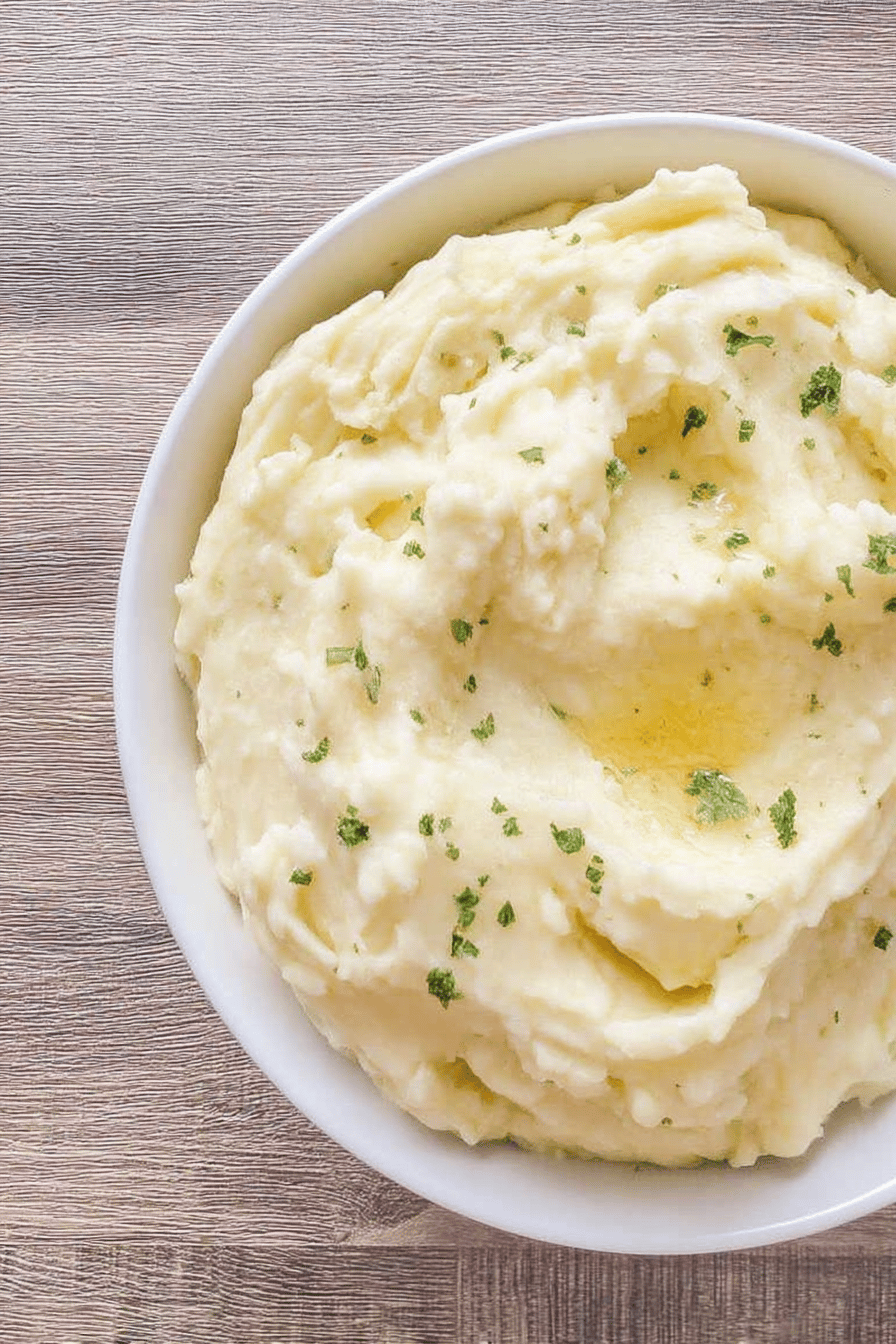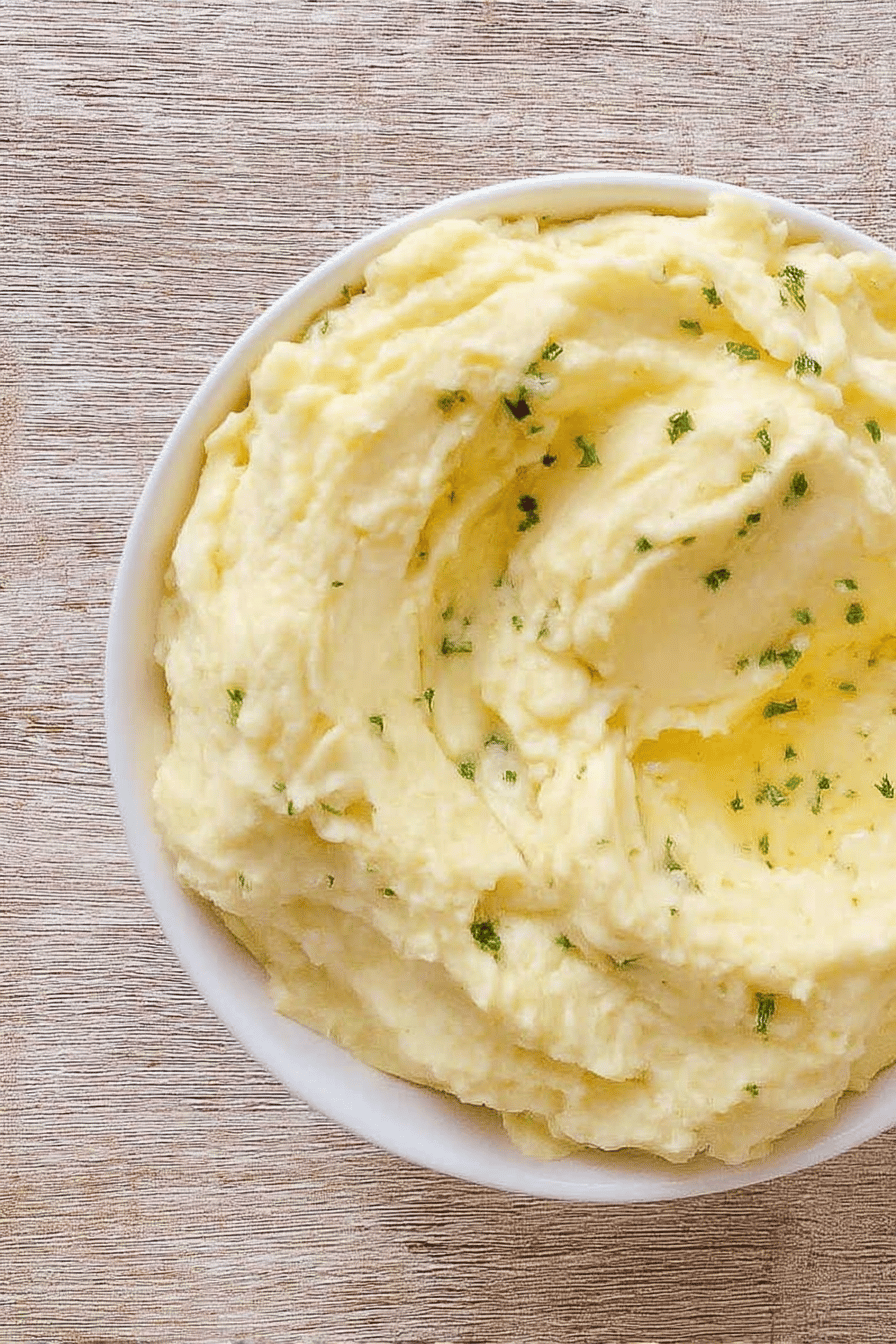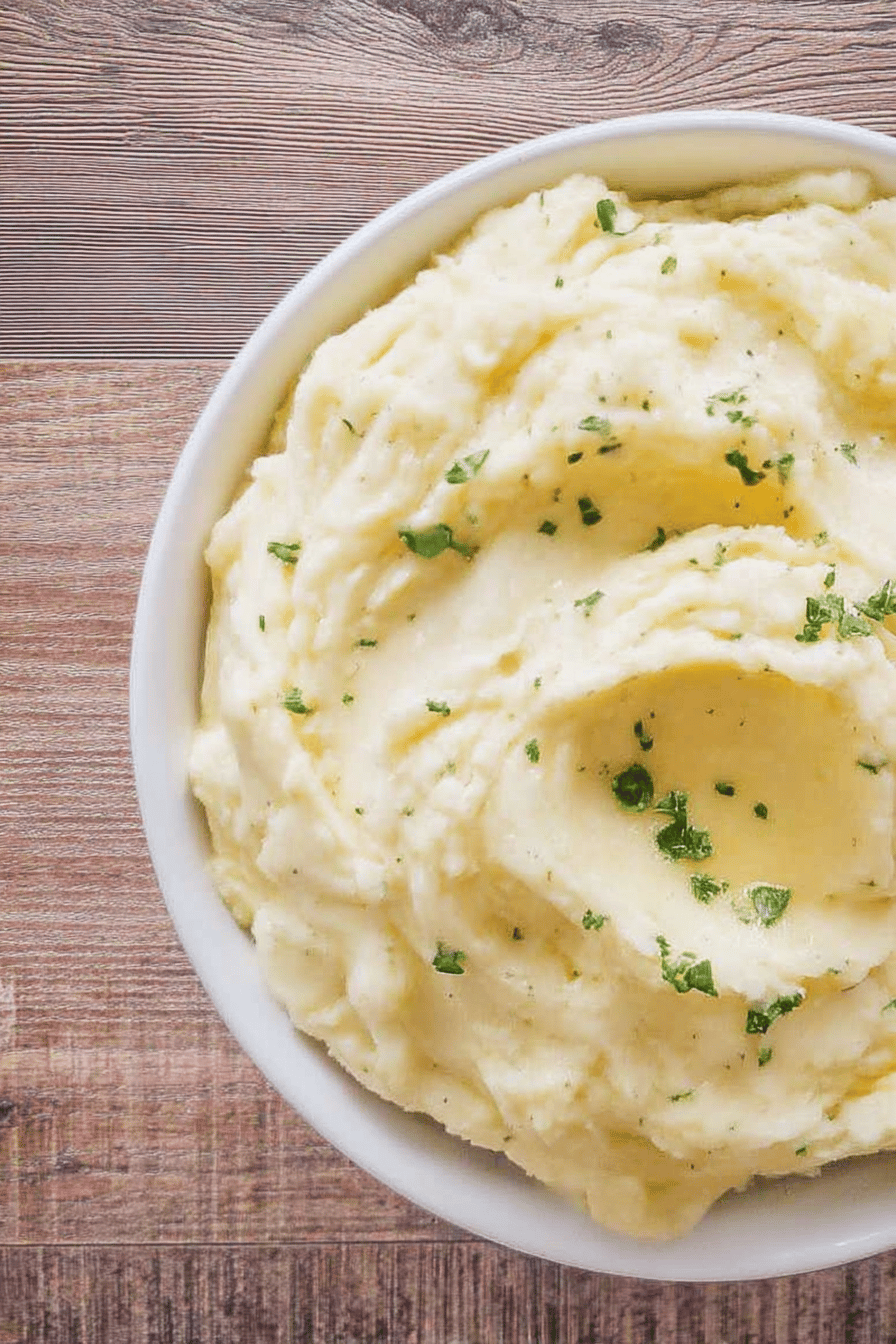Why You’ll Love This mashed potatoes
- Ease of preparation: This mashed potatoes recipe is simple and quick to prepare, making it perfect for busy weeknights. With just a few ingredients and easy steps, you can have creamy mashed potatoes ready in under 40 minutes, saving you time without compromising flavor.
- Health benefits: Mashed potatoes provide essential nutrients like potassium, vitamin C, and fiber, supporting overall wellness. This recipe can be tailored to include healthier alternatives such as using low-fat milk or adding garlic for immune support, making it a nourishing side dish.
- Versatility: These mashed potatoes easily adapt to various dietary needs. Whether you follow a vegan, gluten-free, or low-calorie diet, simple ingredient swaps can modify the recipe to fit your lifestyle without losing its comforting texture and taste.
- Distinctive flavor: What makes this dish special is its rich, buttery creaminess enhanced by subtle seasoning and the option to fold in extras like sour cream or fresh herbs. The balanced flavors produce a classic, creamy mashed potato perfect alongside steak, shrimp, or any hearty meal.
Jump To
- 1. Why You’ll Love This mashed potatoes
- 2. Essential Ingredients for mashed potatoes
- 3. How to Prepare the Perfect mashed potatoes: Step-by-Step Guide
- 4. Dietary Substitutions to Customize Your mashed potatoes
- 5. Mastering mashed potatoes: Advanced Tips and Variations
- 6. How to Store mashed potatoes: Best Practices
- 7. FAQs: Frequently Asked Questions About mashed potatoes
- 8. mashed potatoes
Essential Ingredients for mashed potatoes
- 4 pounds (about 1.8 kg) russet or Yukon Gold potatoes (or a mix) – the base providing fluffy texture and buttery flavor
- 3 cloves garlic (optional) – adds a mild, aromatic flavor
- 1/3 cup (approximately 75 grams) melted salted butter, plus extra for serving – enriches creaminess and mouthfeel
- 1 cup (240 ml) whole milk or cream, warmed – ensures smooth, creamy consistency
- Salt to taste (about 1 to 1 1/2 teaspoons for cooking water and seasoning) – enhances natural flavors
- Black pepper to taste – adds subtle heat and balances richness
- Optional: 1/4 to 1/2 cup (60 to 120 grams) sour cream or cream cheese – boosts richness and adds tangy creaminess
- Garnishes: freshly chopped chives, green onions, or herbs – introduce fresh, bright flavors
Special Dietary Options
- Vegan: Use plant-based margarine or vegan butter, and substitute milk or cream with almond, oat, or soy milk for a dairy-free mashed potato alternative.
- Gluten-free: Naturally gluten-free, this recipe requires no modification for gluten sensitivity.
- Low-calorie: Replace butter with light olive oil and use skim milk or low-fat plant-based milk to reduce calories while keeping creamy texture.
How to Prepare the Perfect mashed potatoes: Step-by-Step Guide
First Step: Prep and Cut Potatoes
Peel the potatoes and cut them into evenly sized quarters or large chunks. This ensures uniform cooking and helps achieve a consistent texture in your mashed potatoes.
Second Step: Boil Potatoes
Place the potato chunks in a large pot and cover with cold salted water, about an inch above the potatoes. Add garlic cloves if using for mild flavor infusion. Bring to a boil over high heat, then reduce the heat and simmer uncovered for 15 to 20 minutes, or until the potatoes are fork-tender.
Third Step: Drain and Steam Off Excess Water
Drain the potatoes thoroughly in a colander. Return them to the warm pot or transfer to a bowl, allowing residual heat to evaporate excess moisture for approximately 5 minutes. This step is essential to achieve light and fluffy mashed potatoes.
Fourth Step: Mash and Incorporate Butter and Milk
Heat the milk or cream until warm (but not boiling). Add the melted butter to the drained potatoes. Begin mashing by hand using a potato masher, gradually incorporating the warm milk or cream until you reach your desired smoothness and creaminess. Avoid using electric mixers to prevent gummy texture.
Fifth Step: Season and Customize
Season the mashed potatoes with salt and freshly ground black pepper to taste. For extra richness, gently fold in sour cream or cream cheese. Adjust the consistency by adding more milk or cream if preferred.
Final Step: Serve and Garnish
Serve the mashed potatoes hot, garnished with additional butter and freshly chopped chives, green onions, or herbs. This makes a perfect side for steak and shrimp stir fry dinners or other hearty meals.

Dietary Substitutions to Customize Your mashed potatoes
Protein and Main Component Alternatives
- Swap traditional potatoes with sweet potatoes or cauliflower for alternative textures and flavors, suited for different nutritional profiles.
- Add mashed white beans or chickpeas for additional plant-based protein while maintaining creaminess.
Vegetable, Sauce, and Seasoning Modifications
- Incorporate roasted garlic or caramelized onions to deepen flavor complexity.
- Use plant-based cream alternatives or nutritional yeast for dairy-free creamy substitutes and a subtle cheesy note.
- Experiment with fresh herbs like rosemary, thyme, or parsley for aromatic dimension.
- Adjust salt and pepper levels to suit dietary sodium restrictions or taste preferences.
Mastering mashed potatoes: Advanced Tips and Variations
Using a ricer or food mill produces ultra-smooth mashed potatoes that avoid overworking and gumminess.
- Pro cooking techniques: After boiling, let potatoes steam dry before mashing to prevent watery mash. Use warm milk to better absorb moisture.
- Flavor variations: Stir in roasted garlic, fresh chopped chives, grated cheeses (cheddar, parmesan), or horseradish for interesting flavor twists.
- Presentation tips: Serve in a warm bowl topped with a pat of melting butter and sprinkle of fresh herbs or cracked black pepper for an inviting look.
- Make-ahead options: Prepare mashed potatoes ahead of time, store in airtight containers, and reheat gently while adding extra milk or butter to refresh texture.
How to Store mashed potatoes: Best Practices
| Storage Method | Guidelines |
|---|---|
| Refrigeration | Store mashed potatoes in airtight containers and consume within 3 days to maintain taste and texture. |
| Freezing | Freeze mashed potatoes in flat layers inside freezer bags for up to 2 months. Thaw in the fridge overnight before reheating. |
| Reheating | Reheat gently on the stovetop or microwave, stirring often and adding milk or butter as needed to keep creamy and smooth. |
| Meal Prep Considerations | Batch cook and portion mashed potatoes into individual servings for quick reheating during busy days with minimal food waste. |


FAQs: Frequently Asked Questions About mashed potatoes
What type of potatoes are best for making creamy mashed potatoes?
Yukon Gold and russet potatoes are ideal for mashed potatoes. Yukon Golds offer a naturally creamy texture and buttery flavor, while russets provide a light, fluffy consistency due to their high starch content. Using a mix of both can balance creaminess and fluffiness. Avoid waxy potatoes like red or new potatoes, as they can make the mash gluey.
How long should I boil potatoes to get the perfect texture for mashing?
Boil peeled potato chunks for 15 to 20 minutes until they are fork-tender. This means the potato pieces should be soft enough to break apart easily when pierced. Avoid undercooking to prevent lumps in your mash. Drain immediately to stop the cooking process and maintain the right moisture level.
Can I freeze leftover mashed potatoes, and what’s the best way to reheat them?
Yes, mashed potatoes freeze well. Store them in airtight containers or freezer bags for up to 2 months. To reheat, thaw in the fridge overnight, then warm in the oven or microwave, stirring occasionally. Adding about one tablespoon of milk or cream per cup of potatoes helps restore creaminess during reheating.
How can I make my mashed potatoes chunkier instead of super smooth?
For chunkier mashed potatoes, hand mash the cooked potatoes with a fork or potato masher, leaving some small lumps. Use less milk or cream and avoid over-mashing or using a potato ricer. This method preserves texture and gives a rustic feel to your mash.
What are some common add-ins to boost flavor in mashed potatoes, and how much should I use?
Popular add-ins include sour cream, cream cheese, shredded cheese, roasted garlic, and fresh herbs like chives or parsley. Use up to half a cup for dairy add-ins per 4 cups of potatoes and a few tablespoons of herbs. Roasted garlic or caramelized onions can be added to taste, usually a few cloves or up to half a cup of onions. These additions contribute flavor without overpowering the potatoes.

mashed potatoes
- Total Time: 35 minutes
- Yield: 10 servings 1x
- Diet: Vegetarian
Description
🥔 Creamy and buttery mashed potatoes, a comforting classic that’s easy to customize for any meal.
🥩🍤 Pairs perfectly with steak and shrimp stir fry, creating a hearty and delicious dinner combination.
Ingredients
4 pounds russet or Yukon Gold potatoes the base providing fluffy texture and buttery flavor
3 cloves garlic adds a mild aromatic flavor
1/3 cup melted salted butter enriches creaminess and mouthfeel
1 cup whole milk or cream ensures smooth creamy consistency
Salt to taste enhances natural flavors
Black pepper to taste
1/4 to 1/2 cup sour cream or cream cheese boosts richness and adds tangy creaminess
freshly chopped chives
green onions
herbs
Instructions
1-First Step: Prep and Cut Potatoes Peel the potatoes and cut them into evenly sized quarters or large chunks. This ensures uniform cooking and helps achieve a consistent texture in your mashed potatoes.
2-Second Step: Boil Potatoes Place the potato chunks in a large pot and cover with cold salted water, about an inch above the potatoes. Add garlic cloves if using for mild flavor infusion. Bring to a boil over high heat, then reduce the heat and simmer uncovered for 15 to 20 minutes, or until the potatoes are fork-tender.
3-Third Step: Drain and Steam Off Excess Water Drain the potatoes thoroughly in a colander. Return them to the warm pot or transfer to a bowl, allowing residual heat to evaporate excess moisture for approximately 5 minutes. This step is essential to achieve light and fluffy mashed potatoes.
4-Fourth Step: Mash and Incorporate Butter and Milk Heat the milk or cream until warm (but not boiling). Add the melted butter to the drained potatoes. Begin mashing by hand using a potato masher, gradually incorporating the warm milk or cream until you reach your desired smoothness and creaminess. Avoid using electric mixers to prevent gummy texture.
5-Fifth Step: Season and Customize Season the mashed potatoes with salt and freshly ground black pepper to taste. For extra richness, gently fold in sour cream or cream cheese. Adjust the consistency by adding more milk or cream if preferred.
6-Final Step: Serve and Garnish Serve the mashed potatoes hot, garnished with additional butter and freshly chopped chives, green onions, or herbs. This makes a perfect side for steak and shrimp stir fry dinners or other hearty meals.
Notes
🥔 Use a mix of russet and Yukon Gold potatoes for a balance of fluffiness and buttery flavor.
💧 Drain potatoes thoroughly and let steam off excess water to avoid gumminess.
♨️ Warm milk or cream before adding to keep potatoes hot and improve absorption.
- Prep Time: 15 minutes
- Cook Time: 15-20 minutes
- Category: Side Dish
- Method: Boiling and Mashing
- Cuisine: American
Nutrition
- Serving Size: 0.5 cup
- Calories: 209
- Sugar: 2 g
- Sodium: 74 mg
- Fat: 7 g
- Saturated Fat: 4 g
- Trans Fat: 0 g
- Carbohydrates: 34 g
- Fiber: 2 g
- Protein: 5 g
- Cholesterol: 17 mg
Keywords: Mashed Potatoes, Steak, Shrimp, Hearty Dinner


These mashed potatoes were so creamy and delicious! 🥔 I added a bit of garlic and chives to mine for some extra flavor, and it turned out great. My family couldn’t stop eating them! Thanks for sharing this fantastic recipe.
★★★★★